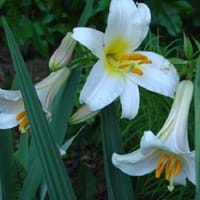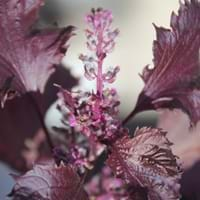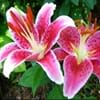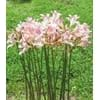Life Span
Perennial
Annual
Type
Bulb or Corm or Tuber
Bush, Houseplant
Origin
Hybrid origin, North America, Europe, Africa, Asia
Eastern Asia, India, Nepal, China
Types
White lily, orange lily, Lily of the valley
Perilla Frutescens Brittain auriculato-dentata, Perilla Frutescens Brittain acuta Kudo, Perilla Frutescens Brittain crispa Hand-Mazz
Number of Varieties
Not Available
Habitat
Not Available
Cultivated Beds, Mountains, Temperate Regions, Tropical areas
USDA Hardiness Zone
2-8
9-11
Sunset Zone
21,22
A1, A2, A3, H1, H2, 1a, 1b, 2a, 2b, 3a, 3b, 4, 5, 6, 7, 8, 9, 10, 11, 12, 13, 14, 15, 16, 17, 18, 19, 20, 21, 22, 23, 24
Habit
Upright/Erect
Upright/Erect
Flower Color
White, Yellow, Red, Green, Purple, Gold, Pink, Rose, Peach, Burgundy, Bronze
White
Flower Color Modifier
Bicolor
Bicolor
Fruit Color
Yellow green, Sandy Brown
Not Available
Leaf Color in Spring
Green, Dark Green
Purple, Burgundy
Leaf Color in Summer
Light Green
Purple, Black
Leaf Color in Fall
Several shades of Green
Purple, Black
Leaf Color in Winter
Light Green
Light Green
Leaf Shape
Long Linear
Cordate
Plant Season
Spring, Summer, Fall
Summer, Fall
Sunlight
Full Sun, Partial Sun, Partial shade
Full Sun, Partial Sun, Partial shade
Type of Soil
Clay, Loam, Sand
Clay, Loam, Sand
The pH of Soil
Acidic, Neutral, Alkaline
Acidic, Neutral, Alkaline
Soil Drainage
Well drained
Average
Bloom Time
Not Available
Summer
Tolerances
Drought
Drought
Where to Plant?
Container, Ground, Pot
Container, Ground
How to Plant?
From bulbs, Seedlings, Seperation
Cuttings, Root Division, Seedlings
Plant Maintenance
Medium
Medium
Watering Requirements
Do Not over Water
Average Water Needs, Never Over-water
In Summer
Lots of watering
Lots of watering
In Spring
Moderate
Moderate
In Winter
Average Water
Average Water
Soil pH
Acidic, Neutral, Alkaline
Acidic, Alkaline, Neutral
Soil Type
Clay, Loam, Sand
Clay, Loam, Sand
Soil Drainage Capacity
Well drained
Moist, Well drained
Sun Exposure
Full Sun, Partial Sun, Partial shade
Full Sun, Partial shade, Partial Sun
Pruning
Prune in early spring, Prune in fall, Remove dead or diseased plant parts
Remove damaged leaves, Remove dead branches, Remove dead leaves
Fertilizers
Compost, Fertilize only when soil is poor, Organic Flower Fertilizer
All-Purpose Liquid Fertilizer
Pests and Diseases
Aphids, Lily Beetle, Stem canker
Aphids
Plant Tolerance
Drought
Drought
Flowers
Showy
Insignificant
Flower Petal Number
Single
Single
Fragrant Bark/Stem
No
Yes
Foliage Texture
Not Available
Medium
Foliage Sheen
Not Available
Matte
Attracts
Birds, Hummingbirds, Not Available, Snails
Butterflies
Allergy
Mild Allergen, Not Available, sneezing
Not Applicable
Aesthetic Uses
Beautification, Showy Purposes
along a porch, deck or patio, Borders, Landscape Designing
Beauty Benefits
Making cosmetics
Not Available
Environmental Uses
Fixes Nitrogen, Indoor Air Purification
Air purification
Medicinal Uses
Burns, Diuretic, Heart problems
Cough, Fever, Lung Problems
Part of Plant Used
Whole plant
Leaves, Seeds
Other Uses
Application in Handicrafts, Basketary, Cosmetics, Oil is used for aromatherapy, Oil is used in mosquito repellents, Used as Ornamental plant, Used for its medicinal properties
Added to salads, Can be boiled and seasoned, pickled, Can be made into a herbal tea
Used As Indoor Plant
Yes
No
Used As Outdoor Plant
Yes
Yes
Garden Design
Alpine, Container, Cutflower, Feature Plant, Mixed Border, Wildflower
Edible, Groundcover, Landscape
Botanical Name
LILIUM
PERILLA frutescens var. purpurascens
Common Name
Lily
Purpleleaf Perilla, Purpleleaf Shiso
In Hindi
लिली
Purpleleaf Shiso
In German
Lilie
Purpleleaf Shiso
In French
Lis
pérille de Nankin
In Spanish
Lirio
Purpleleaf Shiso
In Greek
Κρίνος
Purpleleaf Shiso
In Portuguese
Lírio
Purpleleaf Shiso
In Polish
Lilia
Pachnotka zwyczajna
In Latin
lilium
Purpleleaf Shiso
Phylum
Tracheobionta
Tracheophyta
Class
Liliopsida
Magnoliopsida
Family
Liliaceae
Lamiaceae
Clade
Angiosperms, Monocots
Angiosperms, Asterids, Eudicots
Tribe
Lilieae
Elsholtzieae
Subfamily
Lilioideae
Nepetoideae
Number of Species
Not Available
Importance of Trumpet Lily and Purpleleaf Shiso
Want to have the most appropriate plant for your garden? You might want to know the importance of Trumpet Lily and Purpleleaf Shiso. Basically, these two plants vary in many aspects. Compare Trumpet Lily and Purpleleaf Shiso as they differ in many characteristics such as their life, care, benefits, facts, etc. Every gardener must at least have the slightest clue about the plants he wants to plant in his garden. Compare their benefits, which differ in many ways like facts and uses. The medicinal use of Trumpet Lily is Burns, Diuretic and Heart problems whereas of Purpleleaf Shiso is Cough, Fever and Lung Problems. Trumpet Lily has beauty benefits as follows: Making cosmetics while Purpleleaf Shiso has beauty benefits as follows: Making cosmetics.
Compare Facts of Trumpet Lily vs Purpleleaf Shiso
How to choose the best garden plant for your garden depending upon its facts? Here garden plant comparison will help you to solve this query. Compare the facts of Trumpet Lily vs Purpleleaf Shiso and know which one to choose. As garden plants have benefits and other uses, allergy is also a major drawback of plants for some people. Allergic reactions of Trumpet Lily are Mild Allergen, Not Available and sneezing whereas of Purpleleaf Shiso have Not Applicable respectively. Having a fruit bearing plant in your garden can be a plus point of your garden. Trumpet Lily has no showy fruits and Purpleleaf Shiso has no showy fruits. Also Trumpet Lily is not flowering and Purpleleaf Shiso is not flowering . You can compare Trumpet Lily and Purpleleaf Shiso facts and facts of other plants too.





